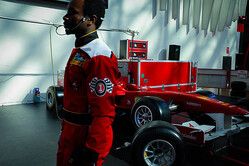


13/10/2021
NEWS STORY
 Looking at the modern racewear and equipment sported by Formula One drivers today, you'd never believe drivers used to wear little to no protective gear. Before the 1960s, race drivers could pretty much wear what they liked. Many famed drivers simply wore golf shirts and slacks.
Looking at the modern racewear and equipment sported by Formula One drivers today, you'd never believe drivers used to wear little to no protective gear. Before the 1960s, race drivers could pretty much wear what they liked. Many famed drivers simply wore golf shirts and slacks.
However, massive changes have been made ever since the Federation Internationale de L' Automobile's introduction of governing mandates regarding the safety of helmets and drivers' suits. This led to several other racewear safety and protection developments that have impacted the motorsport industry forever.
Let's take a look at the key changes that have stuck around.
1) Hardcore Helmets
The first race drivers simply wore caps, and later very lightweight helmets that provided little protection in the event of an accident. It all seems unfathomable now, considering how far safety standards have come. However, the large number of injuries in Motorsports throughout the years made it impossible to let drivers continue racing with minimal protection.
Over time, driving helmets were redesigned to withstand massive impact and resist high temperatures. Made with an outer shell of highly developed composite or AIM materials, modern helmets have features to boost safety, comfort, ventilation, sound isolation, etc. Some brands even boast Bluetooth technology now.
Increased safety standards for Formula One helmets have even influenced other sports gear, like motorcycling Shoei helmets, GPA equestrian helmets, and several types of road or cross-country cycling helmets, to mention a few.
2) Fire-resistant Suits
The well-known fire-resistant race suits were first designed and made around 1963, following several fiery, harrowing accidents on the track. As the story goes, Scottish F1 driver Bill Simpson was introduced to the sport by NASA astronaut Pete Conrad. The fire-proof spec driving suit has been a crucial aspect of race attire ever since.
This advancement made for much safer driving wear. However, it was some years before the suits were anything like what we see today. Now, fire-resistant suits cover most of the body and include a balaclava for the face. They are tightly cinched in around the extremities to keep fire out from any gaps.
3) Lighter Fabrics
At first, the fire-proof suits were thick - consisting of up to five layers - bulky, hot, and rather uncomfortable, leaving drivers feeling like the Pillsbury Doughboy. Since these early days, racewear designers have strived and succeeded in combining comfort and maximum protection.
Nowadays, quintessential Nomex racing overalls are comparatively far more lightweight, cool, and comfortable to wear.
4) Zips, Underwear, Socks, Gloves and Footwear
Along with the update of lighter fabrics, designers realized that everything a driver wears should be fire-resistant, not just suits. So, driving gloves, underwear, socks, footwear, and even any zippers, threading, and anything else on a race suit were also developed to be fire-resistant.
The suits, underwear, socks, gloves, and zippers are also subjected to intense safety testing. They are tested at 600 to 800 degrees Celsius for heat and fire resistance and go through an intensive washing and drying process.
Nowadays, some racewear gloves even boast biometric sensors in the fingertips. The sensors check the driver's vitals and feed data back to the team on the ground. In the event of an accident, this technology helps medical staff to know the driver's condition. The tech mainly measures driver heart rate and oxygen saturation.
Final Thoughts
As you can see, Formula One racewear has made astronomical leaps and bounds since its early days and has changed other industries as well. There has never been more safe and comfortable Formula One racewear than today thanks to developments over the last few decades.
In the future, we can only expect to see more tech upgrades integrated in suits as well as even stronger safety regulations for racewear.